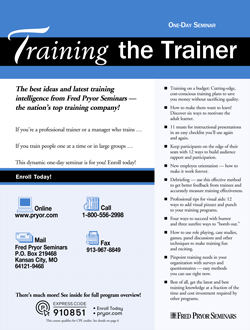More is known today about "how to train" than ever before. Many old methods and once-accepted training practices are disappearing in favor of better, more effective procedures and strategies.
The information and technology explosion has resulted in a rapid change of pace and an "age of specialization." Employee turnover is at all-time highs, and skilled workers are harder and harder to find. To stay competitive, productive and profitable, the successful organization must recognize the need for ongoing, results-driven training programs.
Have you noticed? The best trainers make thorough preparation, exciting presentation, and complete follow-up seem effortless. Whether you're a training specialist, human resources professional, or a manager who trains, you can too — all it takes are practical skills and up-to-date strategies.
You could try to wade through reams of information, research and publications, "boiling it down" to meet your particular needs; or you could attend this outstanding, one-day seminar and learn pertinent, down-to-earth pointers that you can use immediately.
In this seminar, we'll cover:
- Training on a budget: Cutting-edge, cost-conscious training plans to save you money without sacrificing quality.
- How to make them want to learn! Discover 6 ways to motivate the adult learner.
- 11 musts for instructional presentations in an easy checklist you’ll use again and again.
- Keep participants on the edge of their seats with 12 ways to build audience rapport and participation.
- New employee orientation — how to make it work forever.
- Ways ChatGPT/Al enhances training development and delivery
- Debriefing — use this effective method to get better feedback from trainees and accurately measure training effectiveness.
- Professional tips for visual aids: 12 ways to add visual pizzazz and punch to your training programs.
